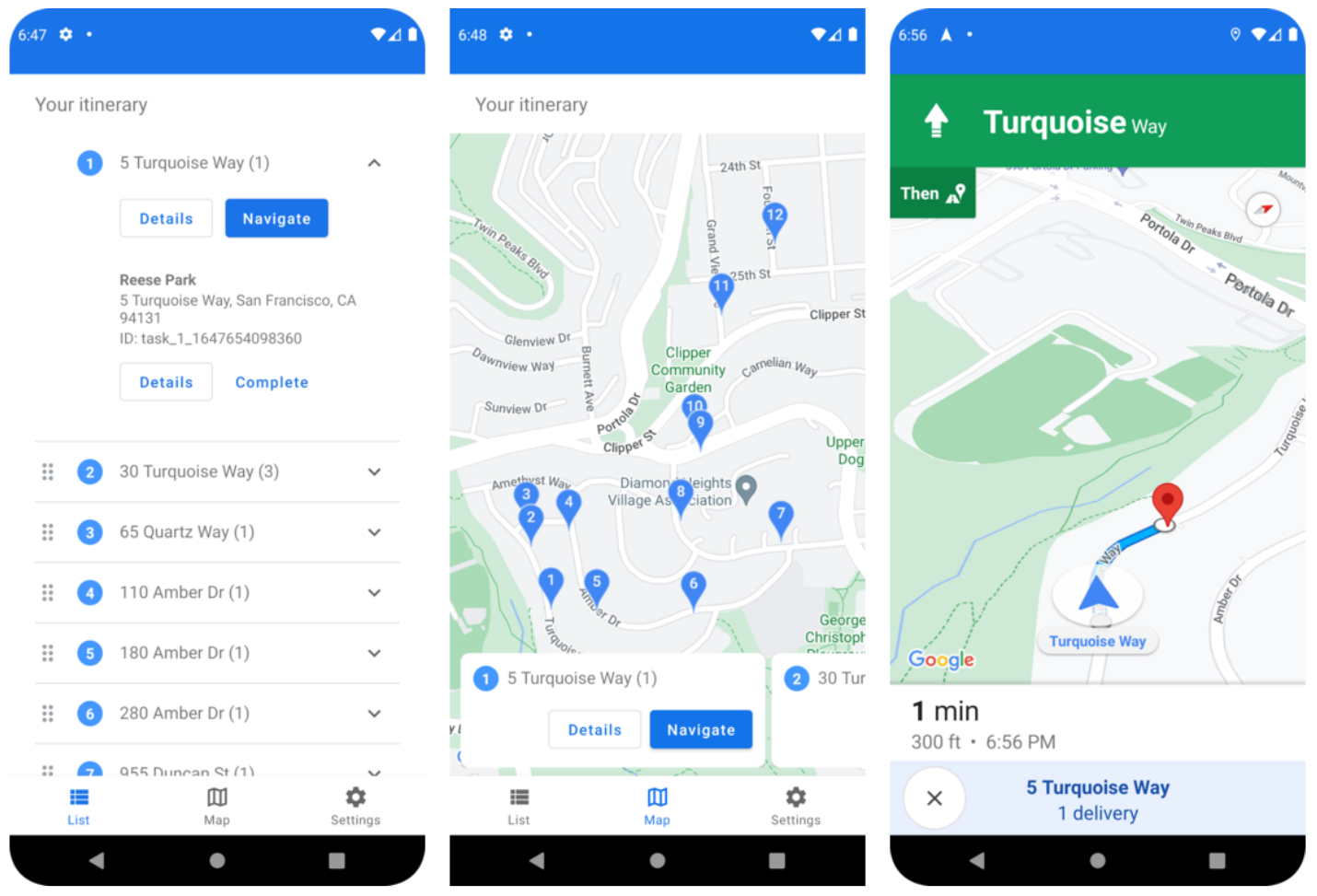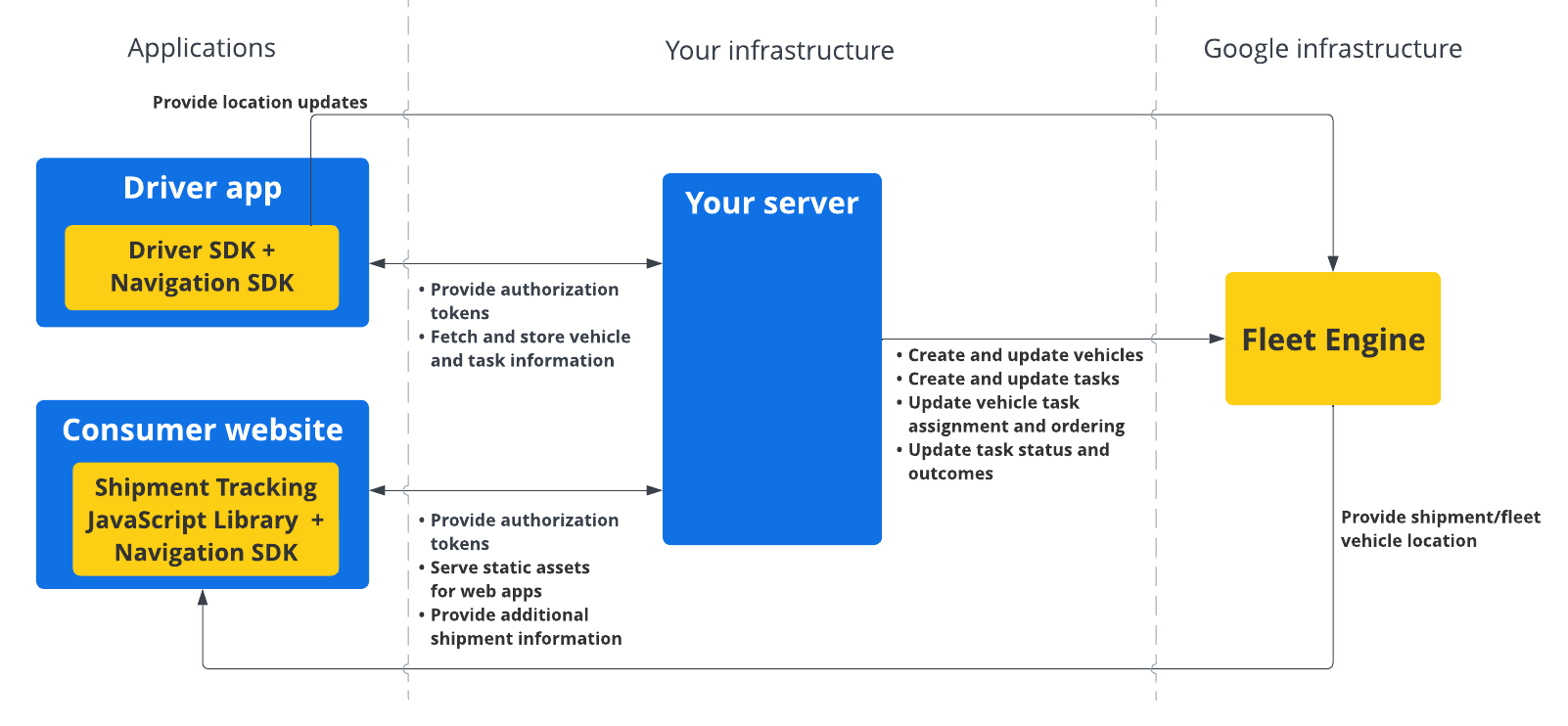
Driver SDK 是一款移动应用工具包,也是 Fleet Engine 的基本组件。借助此 SDK,您的司机应用既可以管理工作分配,也可以启用司机导航和路线规划功能。
准备工作
本指南假定您已阅读以下内容:
什么是用于预定任务的 Driver SDK?
Driver SDK 会将车辆位置和任务更新信息传达给 Fleet Engine,以便 Fleet Engine 管理送货车辆及其分配的送货停靠点和任务。从本质上讲,当司机开始驾驶时,该 SDK 会使用事件监听器将位置更新和经纬度坐标,以及来自 Navigation SDK 的当前路线段和目的地发送到 Fleet Engine。
为何要使用 Driver SDK 来执行预定任务?
借助 Driver SDK,您可以更轻松地与 Fleet Engine 集成,以更新司机的路线。借助此 SDK,司机可以使用单个应用来管理任务和导航,就像使用其消费者版 Google 地图一样,但无需切换到其他应用。
您可以使用 Driver SDK 执行哪些预定任务
使用 Driver SDK 执行预定任务,以便与 Fleet Engine 通信并传达以下信息:
- 地图上配送车辆的实时位置。
- 相应经停点的纬度/经度坐标。
- 到站点的剩余距离。
- 预计到达停靠站的时间。
- 车辆需要行驶的路线,由 Navigation SDK 提供。
Driver SDK 如何处理预定任务
Driver SDK 依赖于 Navigation SDK 来获取路线信息和目的地。Driver SDK 可与您的司机应用集成,并与 Navigation SDK 配合使用,为 Fleet Engine 提供位置更新、纬度/经度坐标、剩余距离和预计到达时间 (ETA) 的数据流。所有其他车辆数据更新都必须发送到客户后端,然后由客户后端将数据中继到 Fleet Engine。

如何使用 Driver SDK 执行预定任务
选择您的平台,了解如何开始使用 Driver SDK。
Android
| 1 | 获取 Driver SDK for Android | 如需了解详情,请参阅获取 Driver SDK。 |
| 2 | 配置 Google Cloud 控制台项目 | 如需了解详情,请参阅配置 Google Cloud 控制台项目。 |
| 3 | 声明依赖项 | 如需了解详情,请参阅声明依赖项。 |
| 4 | 创建身份验证令牌 | 如需了解详情,请参阅创建身份验证令牌。 |
| 5 | 初始化 Driver SDK | 如需了解详情,请参阅初始化 Driver SDK。 |
| 6 | 准备车辆 | 如需了解详情,请参阅准备车辆。 |
iOS
| 1 | 获取 Driver SDK for iOS | 如需了解详情,请参阅获取 Driver SDK。 |
| 2 | 配置 Google Cloud 控制台项目 | 如需了解详情,请参阅配置 Google Cloud 控制台项目。 |
| 3 | 创建身份验证令牌 | 如需了解详情,请参阅创建身份验证令牌。 |
| 4 | 初始化 Driver SDK | 如需了解详情,请参阅初始化 Driver SDK。 |
| 5 | 准备车辆 | 如需了解详情,请参阅准备车辆。 |
后续步骤
请参阅您要设置 Driver SDK 的平台的文档:

